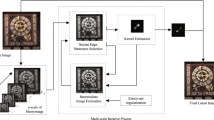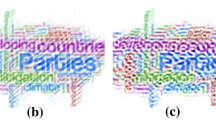Abstract
The full-image based kernel estimation strategy is usually susceptible by the smooth and fine-scale background regions impacting and it is time-consuming for large-size image deblurring. Since not all the pixels in the blurred image are informative and it is frequent to restore human-interested objects in the foreground rather than background, we propose a novel concept “SalientPatch” to denote informative regions for better blur kernel estimation without user guidance by computing three cues (objectness probability, structure richness and local contrast). Although these cues are not new, it is innovative to integrate and complement each other in motion blur restoration. Experiments demonstrate that our SalientPatch-based deblurring algorithm can significantly speed up the kernel estimation and guarantee high-quality recovery for large-size blurry images as well.














Similar content being viewed by others
References
Alexe B, Deselaers T, Ferrari V (2010) What is an object?. In: Computer Vision and Pattern Recognition, pp 73–80
Alexe B, Deselaers T, Ferrari V (2012) Measuring the objectness of image windows. IEEE Trans Pattern Anal Mach Intell 34(11):2189
Bae H, Fowlkes CC, Chou PH (2012) Patch mosaic for fast motion deblurring. In: Asian conference on computer vision, pp 322–335
Bloice MD, Stocker C, Holzinger A (2017) Augmentor: an image augmentation library for machine learning
Chakrabarti A (2016) A neural approach to blind motion deblurring. In: European conference on computer vision. Springer, pp 221–235
Chan TF, Wong C-K (1998) Total variation blind deconvolution. IEEE Trans Image Process 7(3):370–375
Cho S, Lee S (2009) Fast motion deblurring. In: ACM Transactions on graphics (TOG), vol 28. ACM, p 145
Dollár P, Lawrence Zitnick C (2013) Structured forests for fast edge detection. In: ICCV
Dollár P, Lawrence Zitnick C (2014) Fast edge detection using structured forests. ArXiv
Fergus R, Singh B, Hertzmann A, Roweis ST, Freeman WT (2006) Removing camera shake from a single photograph. ACM Trans Graph 25(25):787–794
Goldstein A, Fattal R (2012) Blur-kernel estimation from spectral irregularities. In: European conference on computer vision. Springer, pp 622–635
Hradiš M, Kotera J, Zemčík P, Šroubek F (2015) Convolutional neural networks for direct text deblurring. In: British Machine Vision Conference
Kotera J, Ṡroubek F, Milanfar P (2013) Blind deconvolution using alternating maximum a posteriori estimation with heavy-tailed priors. In: Proceedings of the 15th International Conference on Computer Analysis of Images and Patterns. Springer, Berlin, pp 59–66
Krishnan D, Tay T, Fergus R (2011) Blind deconvolution using a normalized sparsity measure. In: IEEE Conference on computer vision and pattern recognition, pp 233–240
Lawrence Zitnick C, Dollár P (2014) Edge boxes: locating object proposals from edges. In: ECCV
Levin A, Weiss Y, Durand F, Freeman WT (2009) Understanding and evaluating blind deconvolution algorithms. In: IEEE Conference on computer vision and pattern recognition, pp x1964–1971
Li X, Jia J (2010) Two-phase kernel estimation for robust motion deblurring. In: Computer vision - ECCV 2010, european conference on computer vision, Heraklion, Crete, Greece, September 5-11, 2010, proceedings, pp 157–170
Li X, Zheng S, Jia J (2013) Unnatural l0 sparse representation for natural image deblurring. In: Computer vision and pattern recognition, pp 1107–1114
Li X, Ren IS, Ce L, Jia J (2014) Deep convolutional neural network for image deconvolution. In: International conference on neural information processing systems, pp 1790–1798
Na T, Huchuan L, Zhang L, Xiang R (2014) Saliency detection with multi-scale superpixels. IEEE Signal Process Lett 21(9):1035–1039
Pan J, Zhe H, Zhixun S, Yang M-H (2014) Deblurring text images via l0-regularized intensity and gradient prior. In: Proceedings of the IEEE Conference on Computer Vision and Pattern Recognition, pp 2901–2908
Pan J, Sun D, Pfister H, Yang MH (2016) Blind image deblurring using dark channel prior. In: IEEE Conference on computer vision and pattern recognition, pp 1628–1636
Sun X, Zhang L, Huchuan L (2017) Co-saliency detection via partially absorbing random walk. In: Seventh international conference on information science and technology
Wang R, Tao D (2014) Recent progress in image deblurring. arXiv:1409.6838
Yan Q, Li X, Shi J, Jia J (2013) Hierarchical saliency detection. In: Computer vision and pattern recognition, pp 1155–1162
Zhang D, Han J, Han J, Shao L (2016) Cosaliency detection based on intrasaliency prior transfer and deep intersaliency mining. IEEE Trans Neural Netw Learn Syst 27(6):1163–1176
Zhang P, Wang D, Lu H, Wang H, Yin B (2017) Learning uncertain convolutional features for accurate saliency detection
Zhang Q, Lin J, Li W, Shi Y, Cao G (2017) Salient object detection via compactness and objectness cues. Vis Comput 34(4):473–489
Zhe H, Yang MH (2015) Learning good regions to deblur images. Int J Comput Vis 115(3):345–362
Acknowledgements
This work is supported in part by National Natural Science Foundation of China with Nos. 61620106003, 61671451, 61572405, 61502490, 61571439, 61771026, in part by the Open Projects Program of National Laboratory of Pattern Recognition with No.201600038, and in part by the Independent Research Project of National Laboratory of Pattern Recognition with No.Z-2018005 and Project 6140001010207.
Author information
Authors and Affiliations
Corresponding authors
Rights and permissions
About this article
Cite this article
Ma, C., Zhang, J., Xu, S. et al. Accurate blind deblurring using salientpatch-based prior for large-size images. Multimed Tools Appl 77, 28077–28100 (2018). https://doi.org/10.1007/s11042-018-6009-2
Received:
Revised:
Accepted:
Published:
Issue Date:
DOI: https://doi.org/10.1007/s11042-018-6009-2




